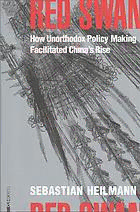
Red Swan: How Unorthodox Policy Making Facilitated China’s Rise PDF
Preview Red Swan: How Unorthodox Policy Making Facilitated China’s Rise
RED SWAN This Page Intentionally Left Blank RED SWAN How Unorthodox Policy Making Facilitated China’s Rise SEBASTIAN HEILMANN The Chinese University Press Red Swan: How Unorthodox Policy Making Facilitated China’s Rise By Sebastian Heilmann © The Chinese University of Hong Kong 2018 All rights reserved. No part of this publication may be reproduced or transmitted in any form or by any means, electronic or mechanical, including photocopying, recording, or any information storage and retrieval system, without permission in writing from The Chinese University of Hong Kong. ISBN: 978-962-996-827-4 Published by The Chinese University Press The Chinese University of Hong Kong Sha Tin, N.T., Hong Kong Fax: +852 2603 7355 Email: [email protected] Website: www.chineseupress.com Printed in Hong Kong CONTENTS vii List of Tables and Figures 1 Introduction China’s Policy Process and the Resilience of the Communist Party-State 17 Chapter 1 China’s Adaptive Governance as a “Red Swan” in Comparative Politics 45 Chapter 2 From Local Experiments to National Policy: The Origins of China’s Distinctive Policy Process 73 Chapter 3 Policy Experimentation and Institutional Innovation in China’s Economic Transformation 115 Chapter 4 How to Combine Policy Experiments with Long-Term Priorities: Unorthodox Lessons from China 131 Chapter 5 Making Plans for Markets: Policy for the Long Term in China 147 Chapter 6 The Reinvention of Development Planning in China 197 Epilogue Changes in China’s Policy Process under General Secretary Xi Jinping 221 Notes 255 Abbreviations 257 Glossary 261 Index LIST OF TABLES AND FIGURES Tables 1.1 Distinctive Contemporary Governance Techniques 37 That Originated During the Revolutionary and Mao Eras (1927–76) 1.2 Transformative versus Protective Policy Styles and 40 Adaptive Capacity 2.1 Establishing “Model Experiments”: A Comparison of 67 the Approaches in the Mao and Deng Eras 3.1 Major Types of Experimental Zones Designated by China’s 85 Central Government 3.2 Patterns of Experimentation in Crucial Areas of Economic Reform 93 3.3 “Experimental Point” Programs in China’s State Sector, 1978–97 95 5.1 Redirecting Plan Functions in China since the 1980s 135 6.1 Binding and Indicative Targets of the 11th and 12th Five-year 156 Plans 6.2 Macro-regional Plans and Experimental Schemes 161 viii | LIST OF TABLES AND FIGURES 6.3 Plan Formulation in China: The Example of the 11th 175 Five-year Plan 6.4 Recombined Governance in Chinese Development Planning 186 7.1 Events That May Trigger a Crisis Mode 202 7.2 Characteristics of the Normal and Crisis Modes in 204 Chinese Politics 7.3 A Stable Exterior with Underlying Fragilities: How Resilient is 207 China’s Political Order to Unexpected Shocks? 7.4 Characteristics and Methods Attributed to a “Chinese 212 Development Model” Figures 3.1 Experimental Regulation in China, 1979–2016 82 3.2 China’s Experimentation-based Policy Cycle 88 7.1 China’s Path to Political and Economic Transformation 199 RED SWAN
